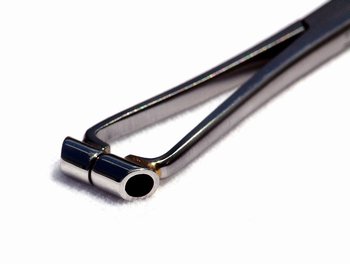Scythian Chieftain and Septum Clamp: Difference between pages
(Difference between pages)
Jump to navigation
Jump to search
(Page conversion via llm-mediawiki-rev -jwm) |
(Page conversion via llm-mediawiki-rev -jwm) |
||
| Line 1: | Line 1: | ||
[[File: | [[File:Septumclamp.jpg|right|thumb|350px]] | ||
'''Septum clamp''' is a tool designed to help piercers achieve a perfect piercing by providing a clear guide. The septum is notorious for being one of the harder piercings to get perfectly straight. | |||
Many talented piercers do not choose to use them; not using one is not indicative of a poor piercer, nor is using one indicative of a good piercer. It's simply a good tool; some may like it, others may not. In addition, it's not a guarantee -- you can still do a crooked piercing using one. | |||
The tool is a standard clamp (usually a modified towel clamp) with a tube welded to the ends. When the clamp is closed, a needle can be cleanly passed through the two halves, making it very easy for the piercer to do a accurate, tissue-perpendicular piercing. | |||
== | ==See Also== | ||
*[[ | * [[Clamps]] | ||
Latest revision as of 11:14, 17 September 2023
Septum clamp is a tool designed to help piercers achieve a perfect piercing by providing a clear guide. The septum is notorious for being one of the harder piercings to get perfectly straight.
Many talented piercers do not choose to use them; not using one is not indicative of a poor piercer, nor is using one indicative of a good piercer. It's simply a good tool; some may like it, others may not. In addition, it's not a guarantee -- you can still do a crooked piercing using one.
The tool is a standard clamp (usually a modified towel clamp) with a tube welded to the ends. When the clamp is closed, a needle can be cleanly passed through the two halves, making it very easy for the piercer to do a accurate, tissue-perpendicular piercing.
